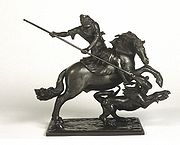
Francesco Fanelli
Encyclopedia

Florence
Florence is the capital city of the Italian region of Tuscany and of the province of Florence. It is the most populous city in Tuscany, with approximately 370,000 inhabitants, expanding to over 1.5 million in the metropolitan area....
, who spent most of his career in England.
He is recorded at work in Genoa
Genoa
Genoa |Ligurian]] Zena ; Latin and, archaically, English Genua) is a city and an important seaport in northern Italy, the capital of the Province of Genoa and of the region of Liguria....
in 1609-10 then worked in London from about 1610, as a sculptor in ivory — Joachim von Sandrart
Joachim von Sandrart
Joachim von Sandrart was a German Baroque art-historian and painter, active in Amsterdam during the Dutch Golden Age.-Biography:Sandrart was born in Frankfurt, but the family originated from Mons...
mentions an ivory statuette of Pygmalion that attracted the attention of Charles I of England
Charles I of England
Charles I was King of England, King of Scotland, and King of Ireland from 27 March 1625 until his execution in 1649. Charles engaged in a struggle for power with the Parliament of England, attempting to obtain royal revenue whilst Parliament sought to curb his Royal prerogative which Charles...
— but mostly as a skilled bronze-caster. He made a fountain of sirens astride dolphins, alternating with scallop shells, with putti clasping fish and other figures, for the king at Hampton Court Palace
Hampton Court Palace
Hampton Court Palace is a royal palace in the London Borough of Richmond upon Thames, Greater London; it has not been inhabited by the British royal family since the 18th century. The palace is located south west of Charing Cross and upstream of Central London on the River Thames...
. It was noticed by John Evelyn
John Evelyn
John Evelyn was an English writer, gardener and diarist.Evelyn's diaries or Memoirs are largely contemporaneous with those of the other noted diarist of the time, Samuel Pepys, and cast considerable light on the art, culture and politics of the time John Evelyn (31 October 1620 – 27 February...
in 1662, and some elements remain, perched on a high rusticated base, as the Diana Fountain in Bushy Park
Diana Fountain, Bushy Park
The Diana Fountain in Bushy Park, on the outskirts of London, England, is a seventeenth-century statue ensemble and water feature in an eighteenth-century setting with a surrounding pool and mile long tree lined vistas...
.
He received a pension in 1635 as "sculptor of the King". His only signed sculpture is a portrait bust
Bust (sculpture)
A bust is a sculpted or cast representation of the upper part of the human figure, depicting a person's head and neck, as well as a variable portion of the chest and shoulders. The piece is normally supported by a plinth. These forms recreate the likeness of an individual...
of a youthful Charles II as Prince of Wales, dated 1640, at Welbeck Abbey
Welbeck Abbey
Welbeck Abbey near Clumber Park in North Nottinghamshire was the principal abbey of the Premonstratensian order in England and later the principal residence of the Dukes of Portland.-Monastic period:...
. He left England in 1642 about the same time as his more conservative rival sculptor, the Huguenot
Huguenot
The Huguenots were members of the Protestant Reformed Church of France during the 16th and 17th centuries. Since the 17th century, people who formerly would have been called Huguenots have instead simply been called French Protestants, a title suggested by their German co-religionists, the...
, Hubert Le Sueur
Hubert Le Sueur
Hubert Le Sueur was a French sculptor with the contemporaneous reputation of having trained in Giambologna's Florentine workshop, who assisted Giambologna's foreman, Pietro Tacca, in Paris, finishing and erecting the equestrian statue of Henri IV on the Pont Neuf...
, also returned to Paris.
Royal inventory references of Charles I note him as "ffrancisco the one-eyed Italian". Charles had two small statuettes of horses in black patination, and George Vertue
George Vertue
George Vertue was an English engraver and antiquary, whose notebooks on British art of the first half of the 18th century are a valuable source for the period.-Life:...
noted that the outstanding horseman and connoisseur of the riding academy, William Cavendish, first Duke of Newcastle at Welbeck had a number of Farinelli's horse statuettes. John Pope-Hennessy has identified as Farinelli's a range of bronze statuettes of St. George and the Dragon and other equestreian subjects. The tomb monument to Sir John Bridgeman and his wife in Ludlow
Ludlow
Ludlow is a market town in Shropshire, England close to the Welsh border and in the Welsh Marches. It lies within a bend of the River Teme, on its eastern bank, forming an area of and centred on a small hill. Atop this hill is the site of Ludlow Castle and the market place...
church has been attributed to him.

